Bit Bang Fest is a free one-day festival dedicated to animation, video games, and digital art.
The post This Saturday in Buenos Aires: Bit Bang Fest appeared first on Cartoon Brew.
Add a Comment
Bit Bang Fest is a free one-day festival dedicated to animation, video games, and digital art.
The post This Saturday in Buenos Aires: Bit Bang Fest appeared first on Cartoon Brew.
Add a Comment
Brazilian studio Lobo knocks it out of the park with this advertising short for textile maker Interface.
The post ‘The Unlikely Hero’ by Guilherme Marcondes appeared first on Cartoon Brew.
Add a Comment
The 2014 Men’s World Cup finals pitted Germany against Argentina. Bets were made and various observations were cited about the teams. Who had the better defense? Would Germany and Argentina’s star players step up to meet the challenge? And, surprisingly, why did Argentina lack black players? Across the globe blogs and articles found it ironic that Germany fielded a more diverse team while Argentina with a history of slavery did not have a solitary black player.
The post An African tree produces white flowers: The disappearance of the black population in Argentina 110 years later appeared first on OUPblog.
Reports are emerging that the Weinstein Company may delay the release of "Underdogs" for the third time.
Add a CommentOn its centennial, a tribute to the 1.5 million victims of the unrecognized Armenian Genocide.
Add a CommentThe Weinstein Company has released the American trailer for "Underdogs," which it will release into U.S. theaters on April 10, 2015.
Add a Comment
As we gear up for the conclusion of the 2014 FIFA World Cup, we’re highlighting some interesting facts about the final four competing nations with information pulled right from the pages of the latest edition of Oxford’s Atlas of the World. Argentina and the Netherlands battled it out in a semi-final match on Wednesday 9 July; Argentina pulled through after a penalty shootout. The team will go head-to-head with Germany on Sunday, 13 July to determine the champion.
Argentina, a two-time World cup winner reached its fifth final when it defeated the Netherlands. The last time it had advanced that far was 24 years ago in 1986. To celebrate their achievement, here are a few facts to think about until then next Cup.
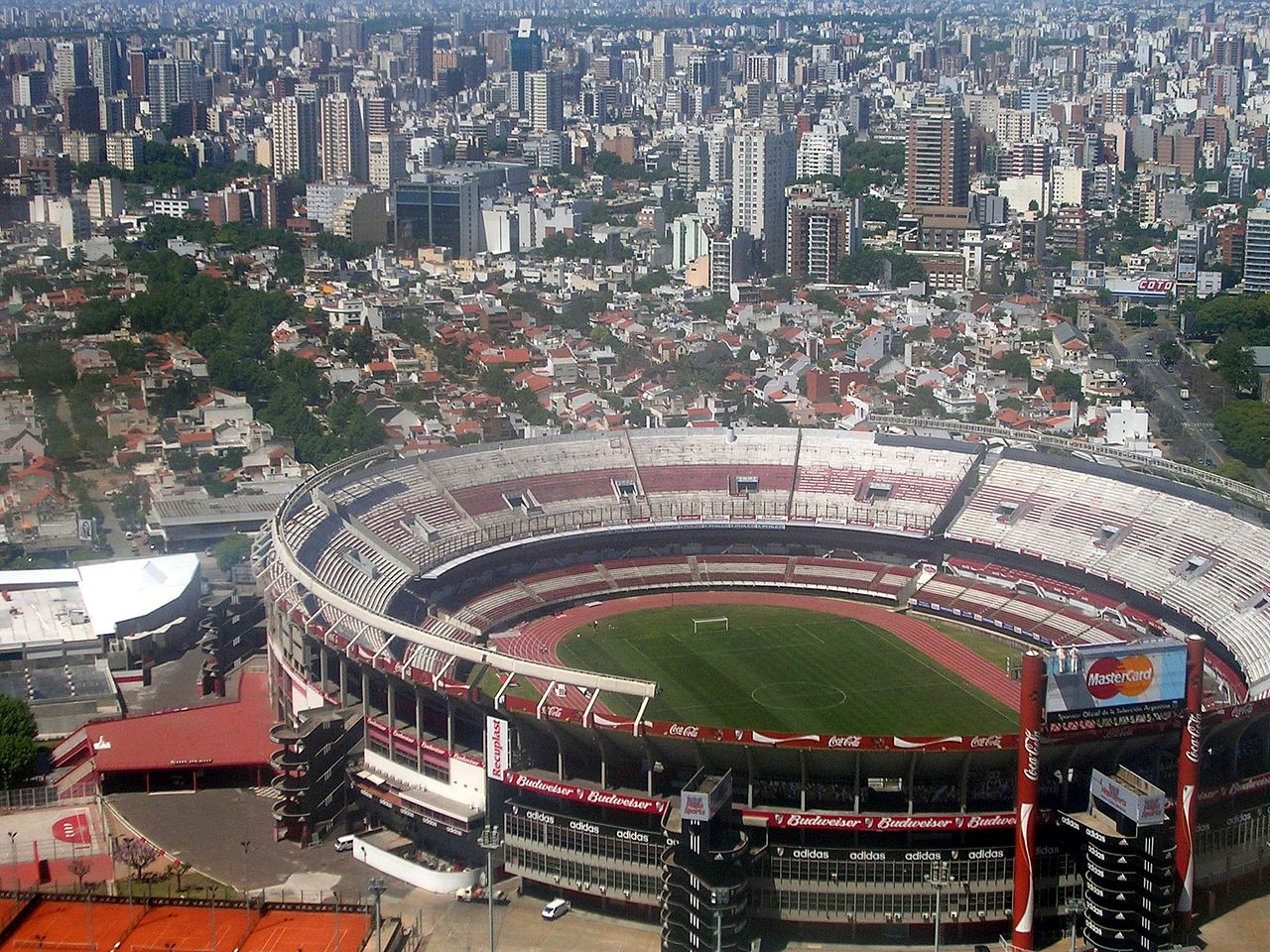
Oxford’s Atlas of the World – the only world atlas updated annually, guaranteeing that users will find the most current geographic information — is the most authoritative resource on the market. The milestone Twentieth Edition is full of crisp, clear cartography of urban areas and virtually uninhabited landscapes around the globe, maps of cities and regions at carefully selected scales that give a striking view of the Earth’s surface, and the most up-to-date census information. The acclaimed resource is not only the best-selling volume of its size and price, but also the benchmark by which all other atlases are measured.
Subscribe to the OUPblog via email or RSS.
Subscribe to only geography articles on the OUPblog via email or RSS.
Image credit: Buenos Aires desde el cielo (Estadio de River). By Elemaki. CC BY 3.0 via Wikimedia Commons.
The post Countries of the World Cup: Argentina appeared first on OUPblog.
Charles Miller claimed to have brought the first footballs to Brazil, stepping off the boat in the port of Santos with a serious expression, his boots, balls and a copy of the FA regulations, ready to change the course of Brazilian history. There are no documents to record the event, only Miller’s own account of a conversation, in which historians have picked numerous holes. There are no images either, which is why to mark the impending Miller-mania surrounding English participation in the World Cup in Brazil, I recreated the scene on the docks at Santos, today South America’s biggest and busiest port. (Thanks to my colleague Gloria Lanci for capturing the solemnity of the occasion).
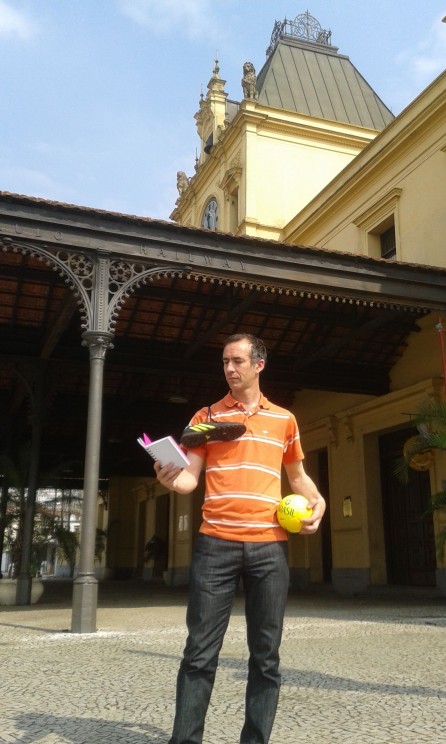
Opposite the passenger terminal, where the photo was taken, an old building is being converted into the Museu do Pelé, to house the history of Santos Futebol Clube’s most famous player, heralded by many as the greatest footballer of the twentieth century – though it will not be ready to open in time for the World Cup. The stories of Miller and Pelé are often linked to illustrate the development of football in Brazil. Gilberto Freyre, the Brazilian sociologist and historian, was one of the first:
‘[It was] Englishmen who introduced into Brazil the principal sporting and recreational replacements for our colonial jousting tournaments: horse-racing, tennis, cycling and football itself, which here became fully naturalised as a game not for fair-haired European expatriates in the tropics but for local people: […] people increasingly of varying shades of brown; with de-Anglicisation culminating in the admirable Pelé, after shining with Leônidas.
[Football] has become a veritable Afro-Brazilian dance, with footwork never imagined by its inventors. Has it stopped being British? Not in the slightest. Association football cannot be separated from its British origins to be considered a Brazilian or Afro-Brazilian invention. What it is, in its current, triumphant expression, is an Anglo-Afro-Brazilian game’. (Gilberto Freyre, The British in Brazil, London, 2011, first published in Portuguese in 1954, p.13.)
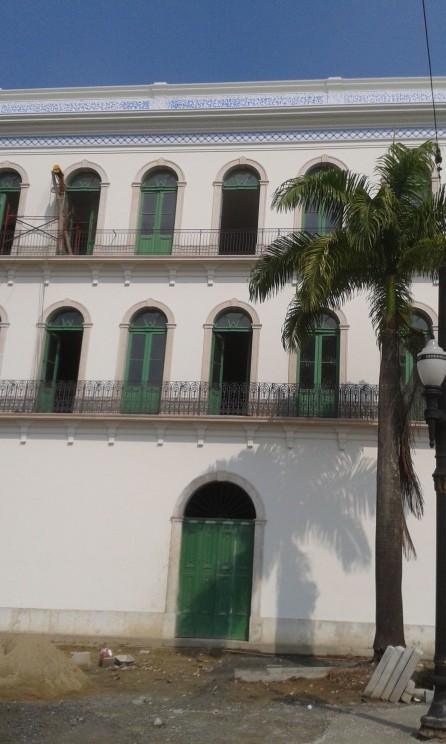
Charles Miller was born in São Paulo to a Scottish father and a Brazilian mother whose surname, Fox, reveals her English origins. During his lifetime the population of São Paulo ballooned from around 100,000 in 1874 to well over 2 million in 1953. Most of those new citizens were migrants and their children. São Paulo and Brazil were remaking themselves. Football and music became central ways for Brazilians to express a new inclusive identity after the abolition of slavery (1888) and the establishment of a new republic to replace monarchy (1889).
The sense of Brazilian football leaving its British origins behind as it headed for global domination on and off the pitch, as suggested by Freyre, is why there is no statue or plaque to Miller in the city, not even in the Praça Charles Miller, the square at the front of the Pacembu stadium which houses the Museu do Futebol. Though he was born and died in Brazil, and lived almost his entire life in Brazil (the exception was his schooling in Hampshire, England) Miller’s legend is that of an immigrant, stepping off the ship in Santos to begin a new life. His ambiguous identity, floating between Scottish, British and Brazilian might explain why his simple grave in the Cemeterio de Protestantes in São Paulo is so modest (a cross marked C.W.M, which the director of the cemetery asked me not to photograph, “out of respect”). The Museu Charles Miller, housed in the exclusive Clube Athletico Sao Paulo, and available to visit on appointment, contains old photographs, trophies and a letter from Pelé.
In Brazilian football historiography, “Charles Miller” has become a cipher for the elite, foreign origins of a game which was were subsequently embraced by the Brazilian povo (the people). Something similar is true of Alexander Watson Hutton for Argentina, a more conventional immigrant figure, a Scot who arrived in Buenos Aires as an adult and set about institutionalising and regulating the game of football through schools, teams and leagues. At the II Simpósio Internacional de Estudos Sobre Futebol that I attended in São Paulo last week, Miller was referenced by many of the researchers as a scene-setter to establish their credentials, his name alone enough to conjure images of moustachioed elite white men in blazers tapping a ball around.
At the Simposio, discussing museums and football with Richard McBrearty, director of the Scottish Football Museum, and Daniela Alfonsi, Diretora de Conteudo do Museu de Futebol, Kevin Moore, director of the [English] National Football Museum, noted that Miller’s story is ‘the very epitome of the multinational, global nature of the origins of football’. But they also pointed out that the origins of football were anything but a one man show. Hundreds of people played football in Brazil at the end of the nineteenth century, and historian José Moraes dos Santos Neto has argued pretty convincingly that football was being played in several places in Brazil before Miller’s much-heralded return from England. The ways in which Brazilians took on the game and made it their own is the subject of many wonderful books, including Alex Bellos’ Futebol: The Brazilian Way of Life and David Goldblatt’s Futebol Nation: A Footballing History of Brazil. The importance of Charles Miller lies not in any individual greatness but in the way that his story has captured something of the essence of being Brazilian, and of the ways in which football was adopted, regulated, internationalised and embraced around the world.
Dr Matthew Brown is a reader in Latin American Studies at the University of Bristol, and specialises in the history of sports in South America. In particular, the history of the very first football teams to be established. He contributed the biographies of Charles Miller and Alexander Hutton to Oxford Dictionary of National Biography’s May update.
The Oxford Dictionary of National Biography online is freely available via public libraries across the UK. Libraries offer ‘remote access’ allowing members to log-on to the complete dictionary, for free, from home (or any other computer) twenty-four hours a day. In addition to 58,800 life stories, the ODNB offers a free, twice monthly biography podcast with over 190 life stories now available. You can also sign up for Life of the Day, a topical biography delivered to your inbox, or follow @ODNB on Twitter for people in the news.
Subscribe to the OUPblog via email or RSS.
Subscribe to only history articles on the OUPblog via email or RSS.
Image credits: (1) Matthew Brown arriving in Brazil, impersonating Charles Miller, © Gloria Lanci. (2) Site of the forthcoming Museu do Pelé, © Matthew Brown.
The post Football arrives in Brazil appeared first on OUPblog.
Animated Fragments is our semi-regular feature of animation tests, experiments, micro-shorts, and other bits of cartoon flotsam that doesn't fit into other categories. To view the previous 25 installments, go to the Fragments archive.
Add a Comment
Maggie Steele, the storybook heroine who vaults over the moon, has been attracting thousands of visitors from around the world. So many visitors, in fact, that she’s using a time zone map to keep track of them all.* People are … Continue reading ![]()
The final trailer (in Spanish) was released today for the Argentinian/Spanish animated feature Metegol (Foosball). The US$21 million film may be most interesting for its unconventional director, Juan José Campanella, whose last film El secreto de sus ojos (The Secret in Their Eyes) won the Academy Award for best foreign language film. He is also a veteran director of American TV series like House M.D., Law & Order and 30 Rock.
As of mid-May, the film’s producers were still negotiating for an American theatrical release, but Metegol is set to open this summer and fall in Argentina, Peru, Spain, Russia, Turkey, the Middle East and Brazil, among other territories. For more, visit the film’s official website or its Facebook page.
Add a Comment
Shave It comes from directors Fernando Maldonado and Jorge Tereso of Bueno Aires, Argentina-based 3dar. The monkey at the center of the film is a stone-faced schemer with an environmentalist agenda. The filmmakers explain:
For us, it’s an ironic reflection about how nature adapts to the human invasion. We found a great inspiration in an Amazonian bird, the Lira, which imitates the sounds it hears in the environment. It does it with such a lack of criticism or judgment that it imitates the other birds singing, the power saws’ noise or the crash of the trees falling in the same way.
The filmmakers push all modes of stylization in this film from a hypersaturated color palette to 2D backgrounds/FX animation mixed in with the computer graphics. The angular monkey is a sight itself, with his shock of wavy electric-blue hair, floating ears, hinged mouth, and mask-like face that makes the stylized animals in DreamWorks’ Madagascar series look like naturalist depictions. All the elements are pulled together with expertise into a fun and attractive package. The development art posted on 3dar’s website gives a small taste of the effort that was invested to explore all the graphic possibilities.
CREDITS
Written and directed by
JORGE TERESO
FERNNADO MALDONADO
Art Direction
MARINA MUÑOZ
Executive production
FEDERICO HELLER
GERMAN HELLER
JORGE TERESO
Graphic design and 2D animation
JULIAN DORADO
3D art
MARTIN BERISSO
JUAN PABLO LANZO
MARCO LOCOCO
SANTIAGO TERESO
FEDERICO CARLINI
Post-production
LUCAS SALVIETTI
Production Assistant
REGINA PORCHIETTI
NATALIA TORIANO
Sound Production
GERMAN HELLER
Music and Foley
JULIEN BEGAULT
CYRILLE MARCHESSEAU
Musical Research
EZEQUIEL BARROS
Animation Direction
FERNANDO MALDONADO
Animation
MARCO LOCOCO
PAULA RAMOS
JORGE TERESO
Rigging
VINCENT SOUZA
MARTIN BERISSO
NAHUEL BELICH
Illumination and Rendering
JORGE TERESO
FEDERICO CARLINI
SANTIAGO TERESO
Creative Support
FEDERICO HELLER
MARINA MUÑOZ
JULIAN DORADO

Curses! I was afraid of forgetting someone in my Buenos Aires post, and I did! Another friendly illustrator I met on my travels was Kelvin Osorio! Gracias Kelvin!
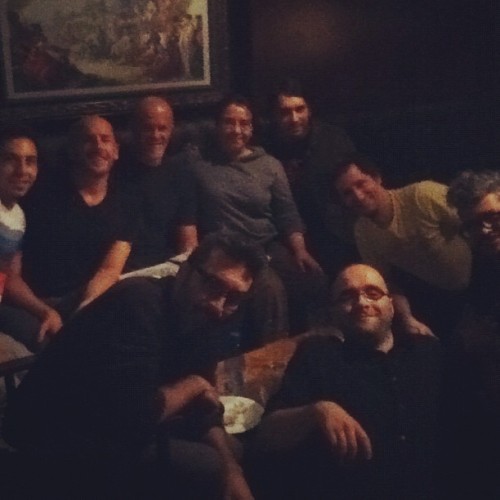
Drunk illustrators at first B.A. Meetup
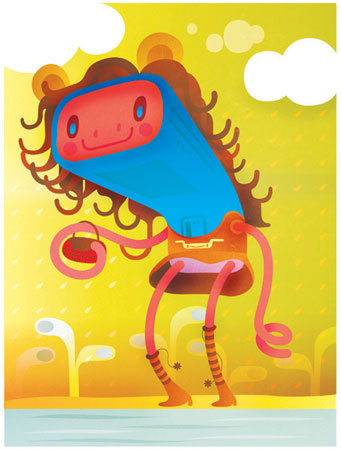
Juliana Pedemont

Lucio Paletta
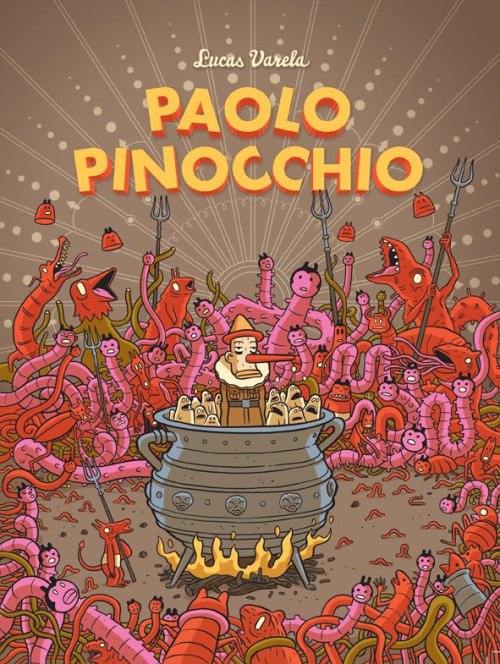
Lucas Varela

Marina Gerosa
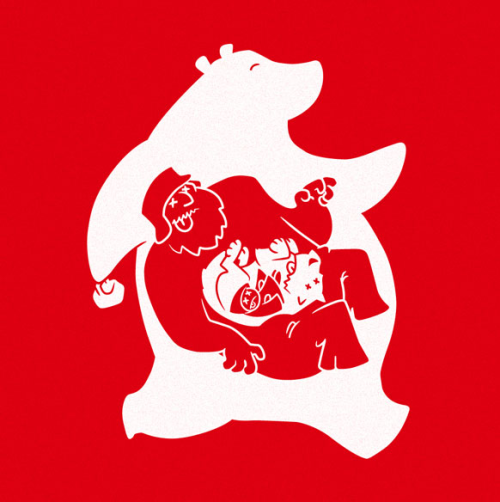
Iván Rodero
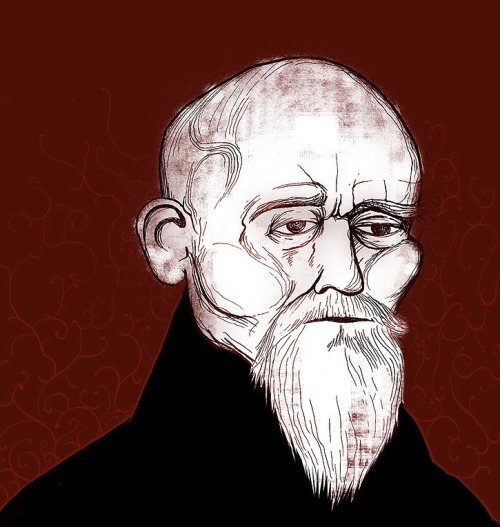
Lluis Rafols

Leonardo Falaschini
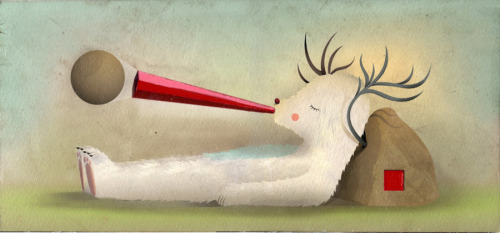
Cristian Turdera

Matias Vigliano
¡Gracias Buenos Aires!
I’m home once again! I’d like to extend a huge THANK YOU to all the wonderful illustrators I met while I was visiting your amazing city. Your friendship and generosity helped make our visit extra special. And a great reminder for all illustrators that a community is always nearby; all you have to do is ask!
- Leonardo Falaschini
- Juliana Pedemont
- Matias Vigliano
- Diego Vaisberg at DGPH
- Naida Ochoa
- Mirella Musri
- Lluis Ráfols (and his 1000 Faces Project)
- Penelope Lugares
- Marina Gerosa
- Iván Rodero
- Vik & Pablo at MonoBlock
- Galeria Mar Dulce
- Wally De Marco
- Lucas Varela
- Lucio Paletta
- Karla Fernandes
- Cristian Turdera
- Nate Williams at IllustrationMundo
Whoo! If I forgot anyone, please let me know!
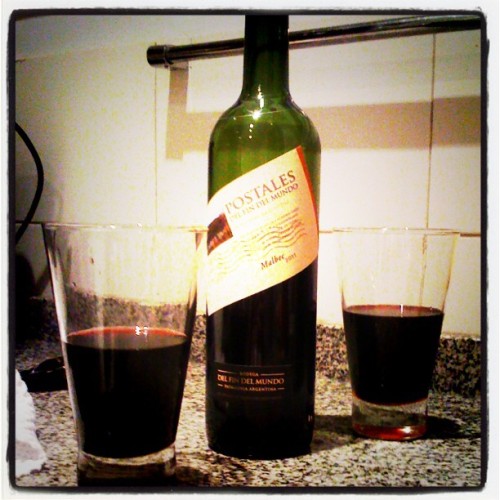
Goodbye cheap Malbec! I think I’ll miss you most of all! (Well, that and Argentine politics! Thank goodness for Google News Alerts.)
We leave Buenos Aires tomorrow, back to Vancouver. Once I’m back, I’ll be posting about our B.A. Illustrator Meetups and links to all the great illustrators I met. I’ll also be writing a post about the joys/downfalls of a “work vacation” as we attempted over the past three months.
¡Adios Argentina! Gracias por todos! Está siempre en nuestros corazones! Besos y abrazos!
~ Luc y Doug
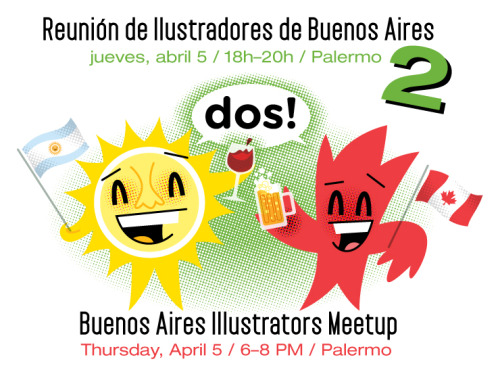
Ilustradores de Buenos Aires, esta noche es nuestra segunda reunión, así que espero que pueda unirse a nosotros! Details are on the Facebook Event page: https://www.facebook.com/events/267807839969414/
If you feel like bringing anything, here are some suggestions
This is mainly a casual meetup, just to chat and have a few drinks. I look forward to meeting you all! :)
cheers,
Luc
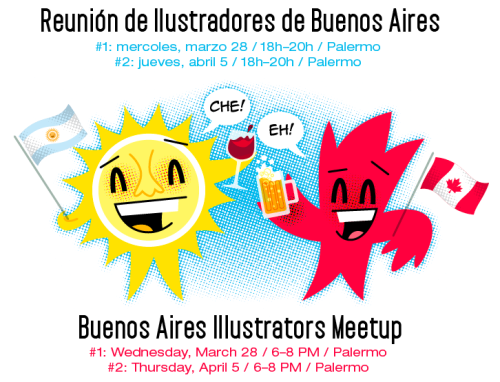
¡Hola Buenos Aires!
He estado de visita en vuestra hermosa ciudad de Buenos Aires por dos meses ya (sólo unas pocas semanas más!) y tenido el gusto de conocer a varios ilustradores locales. Ahora, me gustaría tener la oportunidad de conocer más aun!
La idea es tenet una reunión casual, una noche de la semana próxima (probablemente en un resto-bar del barrio Palermo). Si están interesados, envíenme un mail a [email protected] (contando si van solos o con acompañante) así sabemos la cantidad de gente que vendrá. Tal vez: Si sabe de un buen lugar (que podría tener más de 20 personas), por favor hágamelo saber.
He escogido dos fechas (28 de marzo, y 5 de abril) para que sea más fácil para todos. Voy a mantendremos informados sobre todos los detalles.**
Luego publicaremos fotos del evento, y links a los portfolios de cada uno, aquí en Drawn! :)
Gracias Leonardo Falaschini por ayudarnos con la organización y la traducción! N.del T: Thank you guys!
*Luc añadido y traducido esto con Google Translate, por lo que si hay errores .. lo siento!
¡Hola Buenos Aires!
I have been visiting your beautiful city for two months now (only a few more weeks to go!) and I have had the pleasure of meeting several local illustrators. And now I’d like a chance to meet more of you!
I’d like to suggest a casual meet-up one night next week for drinks (probably at a bar in Palermo). If you’re interested, send me an email at [email protected] (let me know if you’re bringing a friend, or coming alone) so we know how many people to expect. Also: If you know of a good location (one that might hold more than 20 people), please let me know.
I picked two dates (March 28, and April 5) to make it easier for everyone. I’ll keep you posted regarding all the details.
Afterward, I’ll post photos of the event, and links to everyone’s website here on Drawn! :)
ps: Thanks to Leonardo Falaschini for helping with the organizing and the translation!
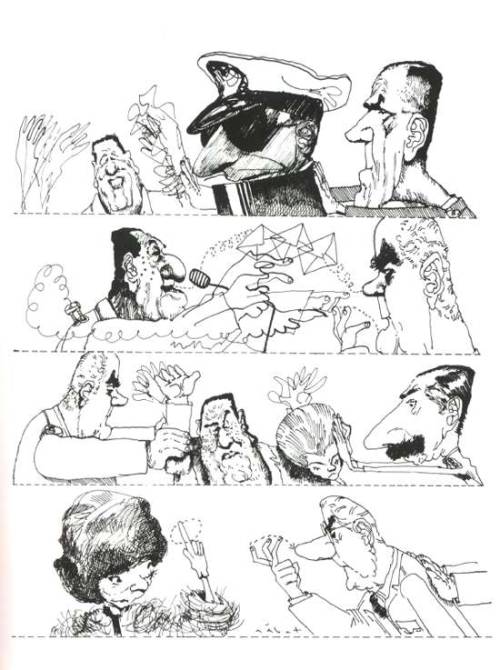
Hermenegildo Sabat, very well-known Uruguayan-Argentine cartoonist, born in 1933. Read more about him on Wikipedia. He’s always been a very outspoken critic and his work has infuriated many a politician. :)

Spain’s Charles I was spurred by the vast Inca wealth to seek further riches in South America. He also wanted to block any effort by Portugal to expand its foothold in Brazil. Accordingly, he commissioned Mendoza to mount an expedition to explore and settle the Río de la Plata, a vast estuary in southern South America that had been sighted back in 1516.
Mendoza set out in August 1535 in command of 800 to 1700 men (accounts vary) in around a dozen ships. The expedition — the largest sent from Spain to the Americas to date — was ill fated, however. A fierce storm blew the ships off course, and after regrouping Mendoza decided that one of his lieutenants was a rebel and had him executed. Troubles continued after the founding of Buenos Aires. At first the Spaniards received gifts of food from the indigenous locals but soon after fighting broke out between the two groups. That conflict cut off the chief source of food, and the Spaniards began to starve. Mendoza sent a lieutenant upriver in search of a friendlier site. He founded Asunción, now the capital of Paraguay.
Mendoza himself headed back to Spain in 1537. He was seriously ill — perhaps from syphilis — and died on the return trip. His settlement continued to struggle, and in 1541 the remaining colonists abandoned it, heading for Asunción. Not until 1580, when Juan de Garay returned to the scene, was a permanent Spanish presence established at Buenos Aires.
“This Day in World History” is brought to you by USA Higher Education.
You can subscribe to these posts via RSS or receive them by email.
Hugo Pratt Interview (en français). I’m not certain when this was shot exactly.
He talks here about how comics are seriously hard work, if you’re doing it right, and about the intense research he’d perform whenever embarking on a new project.
I’ve become a little obsessed with Pratt since arriving here (the apartment we’re staying in has, among many other wonderful books, 13 issues of Pratt’s Corto Maltese, which are helping me learn Spanish!), especially since I realized he also created “Jesuit Joe”, a sort of Native American Robin Hood, riding around the “frozen Canadian North” wearing a stolen RCMP jacket. Boss!
FoxRetro X-Mas Spot by Váscolo (Argentina)
Thor facial rig test in Softimage by Stephen McNally (Ireland)
Strip Tease by Natalianne Boucher, Camille Chabert, Marine Feuillade and Naïmé Perrette (France): “The technique consists of ‘cut-out’ animation (cutted paper, here added to tissues) then back projected on a wall and shot frame by frame.”
African plains, manes and stolen meals by Chris O’Hara (Ireland): “Featuring audio from Planes, Trains and Automobiles.“
X-Ray, Ace & Son studio bumper by Kelsey Stark (US)
Cartoon Brew: Leading the Animation Conversation |
Permalink |
3 comments |
Post tags: Ace & Son, Argentina, Camille Chabert, Chris O'Hara, France, Ireland, Kelsey Stark, Marine Feuillade, Naïmé Perrette, Natalianne Boucher, Stephen McNally, US, Váscolo
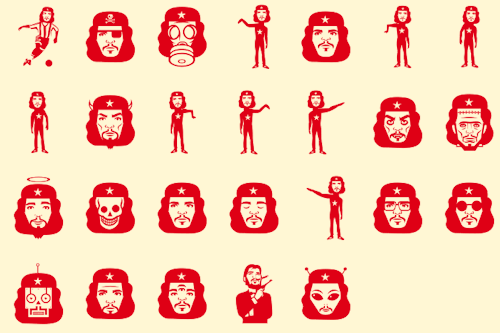
As I’ll be visiting Buenos Aires later this winter, I’ve been reading up on all things Argentinian (including re-watching The Motorcycle Diaries), so I was tickled when I stumbled upon this icon set of the iconic Che Guevara, designed by Jorge Alderete for an Argentinian type foundry named Sudtipos (who also created a lovely Calgary-inspired font named Calgary Script!).
(via SL Che - MyFonts)
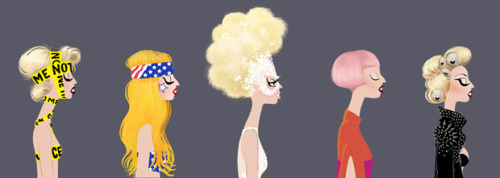



Lady Gaga by Adrian Valencia.
Atsa lotta Gaga. And you should see the rest of Adrian Valencia’s gorgeous illustrations on his website. (His Tumblr has lots more Gagas if you’re interested!!
Face Animation Test by Jonathan Campo (US)
Taste It by Ronda (Argentina)
One Day Animation: Nose Drop by Toby Jackman (UK)
Visual Experiment #1 by Simon Holmedal (UK)
Face Morph by Dan Britt (UK)
Let’s Face Symmetry by 2veinte (Argentina)
Cartoon Brew: Leading the Animation Conversation |
Permalink |
No comment |
Post tags: 2veinte, Argentina, Dan Britt, Jonathan Campo, Ronda, Simon Holmedal, Toby Jackman, UK, US
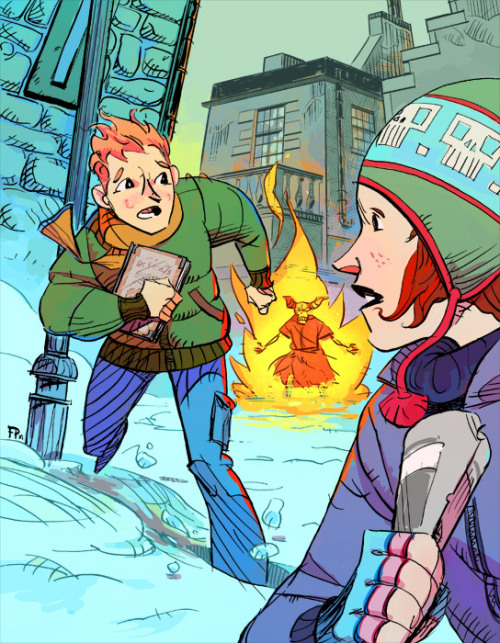
Meet Federico Piatti, everyone. Thanks to Leif Peng for pointing him out on the cyber-matrix today.